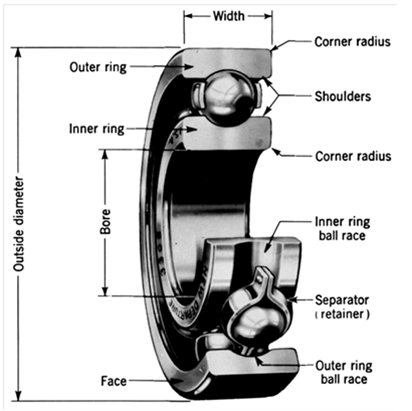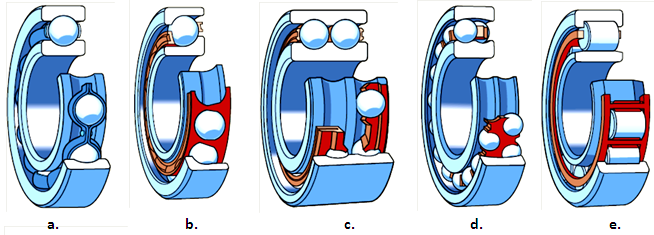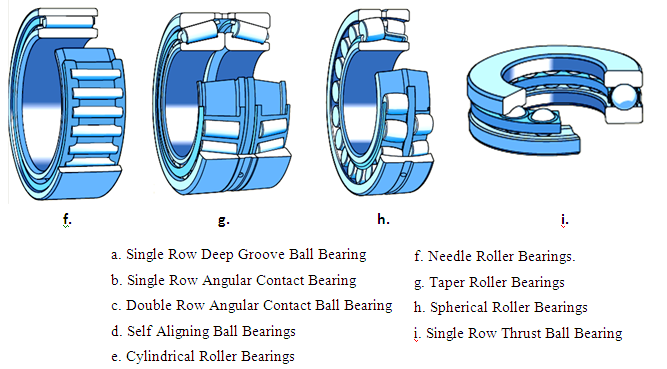Site pages
Current course
Participants
General
MODULE 1.
MODULE 2.
MODULE 3.
MODULE 4.
MODULE 5.
MODULE 6.
MODULE 7.
MODULE 8.
MODULE 9.
MODULE 10.
LESSON 27 INTRODUCTION TO BEARINGS
27.1 Introduction
Every mechanical system involves relative motion between different machine elements. Relative motion leads to loss of power due to friction and deterioration of contacting surfaces due to wear. Bearings are the machine elements that permit relative motion between two components and transmission of load from one to the other, with minimum friction. For example, there is relative motion between a transmission shaft and the housing, in which it is supported. Bearings are provided at the support points of the shaft and they help in reducing power losses due to friction between the shaft and the housing and transmit the loads from the shaft to the housing.
27.2 Classification of Bearings
27.2.1 Depending upon Direction of Load
Radial Bearings
Bearings used to support the load that acts perpendicular to the axis of shaft are called radial bearings. Refer figure 27.1a.
Thrust Bearings
Bearings used to support the load that acts parallel to the axis of shaft are called thrust bearings. Refer figure 27.1b.
27.2.2 Depending upon Nature of Contact
Sliding Contact Bearings
In case of sliding contact bearings, sliding takes place between the moving and fixed elements along the contact surfaces. To reduce friction and wear, sliding surfaces are separated by a lubricating oil film. Sliding contact bearings, shown in figure 27.2a, are also known as plain bearings, journal bearings and sleeve bearings. Applications: engine crankshaft bearings, centrifugal pumps, turbines, large size electric motors, concrete mixers, rope conveyors etc.
Rolling Contact Bearings
In case of rolling contact bearings, rolling elements (balls or rollers) are introduced between the surfaces having relative motion. These bearing thus have rolling friction instead of sliding friction. Rolling contact bearings, shown in figure 27.2b, are also known as antifriction bearings. Applications: automobile axles, gear boxes, machine tool spindles, small size electric motors, crane hooks etc.

Figure 27.1 a. Radial Bearing b. Thrust Bearing

Figure 27.2 a. Sliding Contact Bearing b. Rolling Contact Bearing
27.3 Comparison of Sliding and Rolling Contact Bearings
In sliding contact bearings, starting friction is very high due to metal to metal contact between the two surfaces. Friction reduces gradually as the relative speed increases and the lubricating oil film gets established between the two surfaces having relative motion. But for the condition of pure rolling, friction is zero. That is why rolling contact bearings are also known as antifriction bearings. Although, in actual practice, because of the deformation of contacting surfaces, the type of contact changes from point/ line to surface contact, leading to a positive value of friction.
Because of lesser friction in the rolling contact bearings, the starting torque is very less as compared to operating torque. Due to this reason, these are used in driving units. Maintenance is easy and lubricant consumption is less. Also due to standardization, these are easy to replace. But are sensitive to shock and impact and have limited maximum speed and service life.
On the other hand, sliding contact bearings, due to large lubrication area and load absorbing capacity, are insensitive to impacts and shocks. These can operate at very high speed and have infinite service life. Sliding contact bearings have simple construction and are easy to mount and dismount. But the starting torque and lubricant consumption is very high.
27.4 Rolling Contact Bearings
In rolling contact bearings, the elements of the bearing have a rolling contact. These have following four main parts:
-
Outer Race
-
Inner Race
-
Balls/Rollers
-
Retainers

Figure 27.3 Rolling Contact Bearing
Inner race is mounted on the shaft and rotates along with it. The outer race, fitted in the housing, remains stationary. The two races are held concentric and rolling elements (balls/rollers) are kept between the two. Rolling elements are equally spaced along the circumference and are held separated from each other with the help of retainers. Figure 27.3 shows a typical rolling contact bearing.
Various types of rolling contact bearings are shown in figure 27.4 and are discussed in the following articles.
27.4.1 Single Row Deep Groove Ball Bearing
It is the most common type of rolling contact bearing. It can withstand both axial and radial loads. Under radial loads, contact between balls and races is along a vertical line. Rings get displaced slightly under the axial load and the balls roll in contact with side walls of the races. These bearings are used for supporting shafts in the gearbox.
27.4.2 Single Row Angular Contact Bearing
In this case, races are provided with shoulders (a higher and a lower); in such a way that line through contact points of ball makes an acute angle with the bearing shaft axis. Due to this
angular contact and elliptical contact area, angular contact bearings are suitable for heavy axial loads. Also because of larger number of rolling elements, it can withstand higher radial loads. But it can take up axial loads only in one direction (towards the higher shoulder) and are therefore used in pairs (placed in opposite direction) if axial load is to be supported in both directions. It finds applications in supporting wheel hubs, shafts of differential gear and steering gears like rack and pinion.


Figure 27.4 Types of Rolling Contact Bearing
27.4.3 Double Row Angular Contact Ball Bearing
It is compounded unit of two single row angular contact bearings that can support axial load in opposite directions. These bearings can thus withstand high axial loads in both directions, in addition to the radial load. These bearings are used to support shafts with worm gears, angled spur gears, bevel gears etc.
27.4.4 Self Aligning Ball Bearings
These bearings are provided with a spherical outer race, which allows the deflection of inner race and shaft with respect to the outer race. This helps in compensating deflection or misalignment of the shaft. Radial load capacity of a self aligning ball bearing is lesser than a corresponding deep groove ball bearing. These bearings are used in applications where chances of shaft bending, mounting inaccuracies, misalignment etc. are there e.g. transmissions, agricultural machinery, convening machinery etc.
27.4.5 Cylindrical Roller Bearings
Cylindrical rollers have a line contact with the races due to which cylindrical roller bearing can support larger radial load in comparison to a ball bearing of corresponding size. But their axial load carrying capacity is very less and accurate alignment is also required. Races are provided with flanges to guide the rollers. These bearings are used in electric motors, gearboxes, rail car axles etc.
27.4.6 Needle Roller Bearings
These are special type of cylindrical roller bearings in which the rolling elements are of relatively smaller diameter (1. 5mm to 4.5mm) with length to diameter ratio of 3 to 8. These can take high radial loads and can withstand fluctuating loads also. But these are not suitable for axial loading and are also very sensitive to shaft misalignment. These bearings are used for supporting connecting rods, swivel arms, rocker shafts, spindles etc.
27.4.7 Taper Roller Bearings
In taper roller bearings, taper rollers are used, which have a shape of frustum of a cone. These bearings can take both radial and thrust loads. Rollers and races are so shaped and designed that the production lines drawn from cone and races converge at one point on the axis of the bearing. This helps in attaining pure rolling without slippage along the entire length of the roller. These are also used in pairs to support axial thrust in both directions. Double row taper roller bearings are used to support higher radial and axial thrust in compact space. Taper roller bearings are used for shafts having worm and bevel gears, machine tool spindles, cable pulleys and wheel hubs.
27.4.8 Spherical Roller Bearings
Spherical roller bearings have two rows of spherical rollers that run on a common cylindrical surface of outer race. Inner race retains two rows of rollers and outer spherical race helps in accommodating misalignment between the two races. Due to this advantage of compensation of misalignment and angular deflection of shafts, these also fall in the category of self-aligning bearings. These bearings can withstand high axial as well as radial loads. These are used for cable pulleys, propelling shafts, heavy wheels, crankshafts etc.
27.4.9 Single Row Thrust Ball Bearing
Single row thrust ball bearings have two grooved annular disc plates with balls are retained between them. These are designed for taking only axial loads in one direction with one stationary race way and other attached to rotating member. Due to sliding of balls, friction is higher in these bearings. To decrease friction and reduce contact area, diameter of grooves is kept larger than that of balls. But this restricts the use of thrust ball bearings to lower speeds as at higher speeds the centrifugal force pushes the balls outwards. Moderate misalignment only can be tolerated. These bearings are used for injection pump governor linkage steering boxes and other applications for supporting thrust loads.
References
-
Design of Machine Elements by VB Bhandari
-
Analysis and Design of Machine Elements by V.K. Jadon
-
Machine Design by R.S. Khurmi
-
Design of Machine Elements by C.S. Sharma & K. Purohit
-
SKF General Catalogue